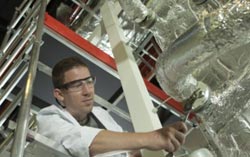Using the Potential of Waste Heat

<br>
In its latest issue the research magazine “Pictures of the Future” reports about the chances of this multi modal energy system. Scientists of Siemens' global research Corporate Techlology want to combine diverse energy sources, such as oil, gas, wind, solar, biomass, and waste heat in a way that ensures they produce electricity, heat, cooling, and potable water in the most efficient and environmentally friendly manner possible.
In most cases, only the individual aspects of such systems were examined until now – for example, approaches for feeding in energy from renewable sources. Now the researcher work with grids that consist of many components and study their interaction and the effect they have on overall stability.
One aspect the researchers are particularly interested is the waste heat from machines and other industrial equipment. Today, waste heat in the low-temperature range in particular is rarely used in an economically viable manner. However, this heat contains valuable energy that can be used to recycle waste water into drinking water, for example. With this in mind, Siemens researchers in Erlangen have developed a demonstration plant which uses waste heat within the temperature range of 70 to 120 degrees Celsius to vaporize wastewater. The resulting steam is channeled into a condenser, where it precipitates in a process that produces pure water and some concentrated wastewater.
In the prototype flows wastewater in from the top through insulated pipes. It then passes through several heat exchangers, where waste heat is used to raise the water's temperature. After that, the wastewater trickles through an evaporator and evaporates. A fan generates an air current that carries the vaporized water upward. The vapor condenses again on the right side, where the condenser is located. The separation is done. To use a minimal amount of electrical energy to transport as much water vapor as possible the temperature distribution and the air volume has to be regulated precisely. The next step could be a pilot facility that would purify 25 cubic meters of water per hour. That would be sufficient to treat the wastewater from bottling processes in the beverage industry. However, the technology can also be used to purify the wastewater generated by brewery processes and oil drilling operations.
The researchers have also built a heat pump that can raise temperatures to a maximum of 140 degrees Celsius – as opposed to the previous limit of 90 degrees. They use a special process fluid for the heat cycle. The new heat pump makes it possible to boost the temperature of industrial waste heat or heat from geothermal sources from between 70 and 90 to 130 degrees Celsius – the norm in district heating systems. The heat could be used to warm buildings.
Media Contact
More Information:
http://www.siemens.com/innovationnewsAll latest news from the category: Ecology, The Environment and Conservation
This complex theme deals primarily with interactions between organisms and the environmental factors that impact them, but to a greater extent between individual inanimate environmental factors.
innovations-report offers informative reports and articles on topics such as climate protection, landscape conservation, ecological systems, wildlife and nature parks and ecosystem efficiency and balance.
Newest articles

Silicon Carbide Innovation Alliance to drive industrial-scale semiconductor work
Known for its ability to withstand extreme environments and high voltages, silicon carbide (SiC) is a semiconducting material made up of silicon and carbon atoms arranged into crystals that is…

New SPECT/CT technique shows impressive biomarker identification
…offers increased access for prostate cancer patients. A novel SPECT/CT acquisition method can accurately detect radiopharmaceutical biodistribution in a convenient manner for prostate cancer patients, opening the door for more…

How 3D printers can give robots a soft touch
Soft skin coverings and touch sensors have emerged as a promising feature for robots that are both safer and more intuitive for human interaction, but they are expensive and difficult…





















